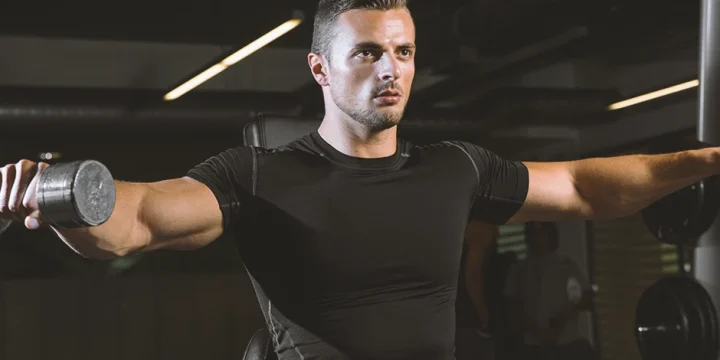Whether you're an athlete or fitness enthusiast, incorporating the sled push into your routine gives impressive results.
As a certified personal trainer, I prioritize this comprehensive exercise for its remarkable benefits.
Together with a group of my clients, all exercises underwent thorough testing to ensure that individuals of all fitness levels and athletes could benefit from this exercise.
After reading this article, you will have the necessary knowledge to integrate sled drive workouts into your weekly routine seamlessly.
Quick Summary
- A sled push workout involves pushing a weighted sled, targeting multiple muscle groups, including the quadriceps, glutes, hamstrings, calves, and core.
- Sled pushes can be adapted to suit different fitness levels by adjusting the weight and distance, making them suitable for beginners and advanced.
- According to a study by East Tennessee State University, sled push exercises significantly increase speed, boost performance, and aid in calorie burning.
- Personally, I find sled pushes to be an incredibly versatile and rewarding part of a fitness regimen, offering a unique blend of strength, endurance, and cardiovascular training.
How to Do a Sled Push Workout?

To perform the sled push, I've found that you really need a good quality prowler sled, a non-friction surface like turf (which I personally prefer for its give and resistance), and a set of weight plates. Getting these basics right makes all the difference in the effectiveness of the workout.
Once you have gathered all the requirements, you can proceed by following these simple instructions:
1. Set up the Sled and Position Yourself
Load the sled with an appropriate quantity of weight based on your fitness level and goals. Make sure the weight is evenly distributed and secure.
Once loaded, you can position yourself behind the sled with your feet shoulder-width apart, bend your knees, and get into a low athletic stance.
Firmly grasp the sled using vertical posts or horizontal hand grips, ensuring you have sufficient grip to push aggressively.
2. Engage Your Core and Start Pushing as Hard as You Can
Tighten your core muscles to stabilize your body and maintain proper alignment throughout the exercise [1].
Start pushing through the ball of the foot, rapidly extending through the hip, knee, and ankle joints by driving through your legs and pushing the sled ahead.
Focus on generating force from your lower body, specifically your quads, hamstrings, and glutes.
While you push, drive the other leg forward, attacking back at the ground for the next step.
Read More: Best Core Exercises for Men and Women
3. Maintain a Steady Pace and Keep Your Back Straight

Keep a consistent and controlled pace as you push the sled.
Avoid jerky or uncontrolled movements that can put a strain on your joints.
Keep your back straight, your chest up, and your eyes forward throughout the movement.
This posture helps maintain alignment and reduce the risk of injury.
4. Push the Sled for a Specific Distance or Time, Rest, and Repeat
From my experience, the key to a successful sled push session is to set clear goals for distance or time.
In my training programs, I've found that varying these elements keeps the workouts challenging and engaging, whether it's pushing for longer distances or aiming for faster times.
To get the most out of the sled push, also known as sled pull, avoid letting your ankle collapse once your foot is on the ground; that way, you engage the calf and foot muscles and develop strength throughout the entire leg.
After completing the push, rest briefly before repeating the exercise for the desired number of sets or as prescribed in your workout plan.
Sled Push Workouts for Endurance

To enhance muscle endurance using a sled, follow these steps:
- Weighted sled with a lightweight, around 25% of your maximum load, or a weight you can push for 10 minutes with breaks. Beginners may opt for no weight.
- Position yourself behind the sled and grasp the poles with high-grip hand placement.
- Activate your core muscles and begin pushing the sled, focusing on generating power from your entire leg. Extend your hips and knees as you propel the sled forward, maintaining a foot stance similar to your natural running position.
- Perform this exercise for 1 minute.
- Take a rest period of 30-60 seconds.
- Repeat the 1-minute sled pull followed by a 30-second rest period for a total of 5-10 cycles.
Sled Push Workouts for Power

For an effective sled push workout targeting power, follow these steps:
- Weighted sled with a moderate weight or heavy, aiming for around 70% of your maximum load. If you're unsure, opt for a weight that is approximately 70% of your body weight.
- Position yourself behind the sled and grasp the poles using a medium-to-high-grip hand placement.
- Activate your core muscles and initiate the sled pull, pushing forward with maximum speed and power, utilizing your full leg strength. Extend your hips and knees as you propel the sled forward, maintaining a foot stance similar to your natural running position.
- Push the sled for a distance of 10-25 yards.
- Rest for 30-60 seconds.
- Repeat the sled push for a total of 4-6 sets, ensuring to rest for 30-60 seconds between each set.
"Incorporating sled push workouts into your training routine can improve your sprinting speed and power. It's a valuable tool for athletes who rely on explosive movements."
- Shaun Stafford, Fitness Trainer at City Athletic
Sled Push Workouts for Fat Loss

When I focus on sled push workouts for fat loss with my clients, we aim for a balance of moderate to high intensity. I've noticed that keeping the rest periods short and maintaining a higher heart rate really amps up the calorie burn.
These sled drive exercises for fat loss can help elevate your heart rate, increase calorie burn, and simultaneously engage multiple muscle mass groups.
For a powerful sled push workout that specifically targets fat loss, follow these essential steps:
- Weighted sled with a light load or weighted sled pushes than you would use for a power sled pull workout if you want to burn fat with a sled.
- Stand behind the sled and grasp the poles with a firm grip, ensuring your hands are positioned comfortably.
- Engage your core muscles and initiate the sled push. Push the sled forward as quickly as possible, driving through your legs and utilizing your entire body for maximum exertion. Focus on maintaining a strong push.
- Push the sled for a distance of approximately 10-20 yards or a distance that challenges your endurance and strength.
- Take a brief 30-60 seconds rest to recover and prepare for the next set.
- Repeat the sled drag for a total of 4-6 sets, allowing for 30-60 seconds of rest between each set.
Also Read: Fat Loss vs Weight Loss: Vital Differences Explained
Sled Push Workout for Sprinting Speed

To improve your sprinting speed using a sled, follow these steps:
- To begin, load the sled with a weight equivalent to 25% of your maximum load. If unsure, select a weight that allows you to push the sled for 10 minutes with short breaks.
- Position yourself behind the sled, grasping the poles with a high-grip hand.
- Activate your core muscles and initiate the sled pull, exerting maximum effort and speed while driving through your entire leg. Extend your hips and knees as you propel the sled forward, maintaining a foot stance resembling your natural running position.
- Push the sled for a distance of 10-20 yards.
- Rest for a period of 30-60 seconds.
- Repeat the sled push 4-6 times, ensuring to rest for 30-60 seconds between each set.
Sled Push Muscles Worked

Sled exercises are a highly effective full-body workout that engages different muscle groups simultaneously.
Quadriceps
The quadriceps muscles located in the front of the thigh are heavily activated during sled pushes.
They are responsible for extending the knee joint as you push the sled.
Glutes
The gluteal muscles, including the gluteus maximus, medius, and minimus, are engaged to provide power and drive during the pushing motion [2].
They help extend the hips as you generate force to move the sled.
Hamstrings
The muscles at the back of the thigh, known as the hamstrings, play a crucial role in the sled push.
They assist in extending the hips and work in conjunction with the glutes and quadriceps to generate force.
Core muscles

The core muscles, including the abdominals, obliques, and lower back muscles, play a vital role in maintaining stability and transferring force from the lower body to the sled.
According to an article published by the National Strength and Conditioning Training, they help to stabilize the spine and maintain proper posture during the exercise [3].
Upper body muscles
While sled exercises primarily focus on the lower body, the upper body muscles are also engaged to provide stability and control.
Muscles in the shoulders, arms, and upper back assist in maintaining a firm grip on the sled handles and contribute to overall body coordination.
Sled pushes provide a comprehensive workout for the lower and upper body, making them excellent exercises for building strength, power, and conditioning.
Sled Pushes for Specific Athletic Training
By incorporating sled pushes into their training regimen, athletes can see significant improvements in areas crucial for their sport.
In sports like track and field, football, and rugby, explosive power and speed are critical. Sled pushes mimic the explosive forward movement required in these sports.
By adjusting the weight on the sled, athletes can train their bodies to generate quick, powerful bursts of speed. This training is particularly beneficial for sprinters, football linemen, and rugby players who need to exert maximum force in a short time.
For sprinters, lighter sleds with a focus on rapid acceleration can mimic the start of a race. Football and rugby players, on the other hand, might opt for heavier sleds to build the raw power needed for tackling and scrummaging.
The key is to adjust the sled weight and pushing distance to align with the specific demands of the sport.
Benefits of a Sled Push

According to a study by East Tennessee State University, sled push is a full-body strength, power, and speed exercise that increases speed, boosts performance, and burns calories [4].
Sled push offers a range of benefits for individuals incorporating them into their workout routines. Some of the key benefits of sled push include:
Full-Body Workout Engagement
Sled pulls primarily focus on lower body muscles but also engage the core and upper body muscles to stabilize and propel the sled.
This full-body engagement promotes overall strength development and functional fitness.
All these muscles will be engaged whether you add weight to the sled or not.
Strength and Power
Sled pulls are an effective way to build lower body strength and power.
The pushing motion targets muscles such as the quadriceps, hamstrings, glutes, and calves, helping to develop muscular strength and explosiveness.
Cardiovascular Endurance
Pushing a sled requires significant cardiovascular effort, making it an excellent exercise for improving endurance and cardiovascular fitness.
It elevates the heart rate and challenges the cardiovascular system, leading to enhanced stamina over time.
Versatility and Adaptability

Sled push exercise can be modified and adjusted to suit different fitness levels and goals.
Customize the weight on the sled and vary the distance or duration of each push to enable progressive overload and create tailored workouts.
With the ability to customize, the sled push grants you the power to design workouts that precisely align with your goals, ensuring maximum effectiveness and optimal results.
Functional Fitness
Sled pulls simulate real-life activities that require pushing or exerting force, such as pushing a car or moving heavy objects.
By training with sled push, individuals can improve their ability to perform everyday tasks and activities that demand physical strength and endurance.
Fat Burning and Reduce Body Weight

Sled drags are a high-intensity exercise that can contribute to calorie burning and fat loss.
The combination of strength sled training and cardiovascular exertion during sled pushes can help increase metabolic rate and support weight management goals.
Mental Resilience
Sled push can be mentally challenging, requiring focus, determination, and pushing through physical discomfort.
Regularly incorporating sled pushes into a workout routine can help build mental resilience, discipline, and a sense of accomplishment.
It's important to note that the sled push benefits experienced may vary depending on factors such as individual fitness levels, training intensity, and consistency.
"One of the great benefits of sled push workouts is their scalability. You can adjust the weight and distance to suit your fitness level, making them suitable for beginners and advanced athletes alike."
- Tony Horton, Fitness Trainer
FAQs
How Often Can I Do Sled Pushes?
The frequency of sled pushes can vary depending on your fitness level. As a general guideline, beginners can start with 1-2 sessions per week; intermediate individuals can aim for 2-3 sessions per week; advanced individuals may incorporate sled push 3-4 times per week.
Are Sled Pushes Suitable for Beginners?
Sled pushes can be adapted for beginners by starting with lighter weights and shorter distances. It's important to start at a comfortable intensity and gradually progress as strength and conditioning improve.
Supplementation That Helps to Perform Sled Push
Our first-hand experience shows that sled push exercises are a valuable way to improve full-body workouts and enhance lower-body strength and stability.
Sled pushes provide a dynamic and functional full-body exercise by engaging multiple muscle groups and simulating real-life movements.
Whether you're an athlete, fitness enthusiast, or looking to diversify your training routine, incorporating sled pushes can yield significant benefits for strength, conditioning, and athletic performance.
Our research can also confirm that incorporating supplements such as pre-workout formulas will maximize gains:
Quality pre-workouts can enhance performance and aid recovery after sled drive exercises.
References:
- https://www.ncbi.nlm.nih.gov/pmc/articles/PMC7345922/
- https://www.physio-pedia.com/Gluteal_Muscles
- https://www.nsca.com/contentassets/79bfa916ec694b10a4ae3bcc79f19476/ptq-4.2.9-core-development-through-the-use-of-sled-training.pdf
- https://dc.etsu.edu/cgi/viewcontent.cgi?article=3783&context=etd
About The Author
You May Also Like






